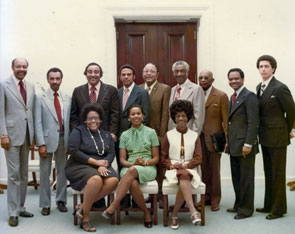Black Americans in Congress: An Introduction
Permanent Interests: The Expansion, Organization, and Rising Influence of African Americans in Congress, 1971–2007
 Propelled by the Congressional Black Caucus, African-American Members of Congress steadily gained seniority and power in the House of Representatives. In this late 1970s picture from left to right (standing) are: Louis Stokes of Ohio, Parren Mitchell of Maryland, Charles Rangel of New York, Andrew Young, Jr., of Georgia, Charles Diggs, Jr., of Michigan, Ralph Metcalfe of Illinois, Robert Nix, Sr., of Pennsylvania, Walter Fauntroy of the District of Columbia, Harold Ford, Sr., of Tennessee; seated from left to right: Cardiss Collins of Illinois, Yvonne Brathwaite Burke of California, and Shirley Chisholm of New York.Image courtesy of Moorland–Spingarn Research Center, Howard University
Propelled by the Congressional Black Caucus, African-American Members of Congress steadily gained seniority and power in the House of Representatives. In this late 1970s picture from left to right (standing) are: Louis Stokes of Ohio, Parren Mitchell of Maryland, Charles Rangel of New York, Andrew Young, Jr., of Georgia, Charles Diggs, Jr., of Michigan, Ralph Metcalfe of Illinois, Robert Nix, Sr., of Pennsylvania, Walter Fauntroy of the District of Columbia, Harold Ford, Sr., of Tennessee; seated from left to right: Cardiss Collins of Illinois, Yvonne Brathwaite Burke of California, and Shirley Chisholm of New York.Image courtesy of Moorland–Spingarn Research Center, Howard UniversityThis post-civil rights movement generation of lawmakers created a legislative groundswell on Capitol Hill. Civil rights acts of the 1960s and court-ordered redistricting opened new avenues of political participation for millions of African Americans. Consequently, many more blacks were elected to political office, and even to Congress. Eighty-six of the 121 African Americans who had served in congressional history through 2007—more than 70 percent—were seated in Congress after 1970. Many of these Members were elected from southern states that had not been represented by blacks in seven decades or more, for example, Representative Andrew Young of Georgia (1973–1977), Barbara Jordan of Texas (1973–1979), and Harold Ford, Sr., of Tennessee (1975–1997). During the 1992 elections alone the total black membership in Congress grew by one-third and Carol Moseley-Braun of Illinois (1993–1999) was elected as the first black woman and the first African-American Democrat to serve in the U.S. Senate.
With the ranks of African Americans growing in Congress, the time for formal organization and coordination of black efforts had arrived. In early 1971, 13 African-American Members of Congress led by Charles C. Diggs, Jr., of Michigan (1955–1980), formed the Congressional Black Caucus (CBC) to address “permanent interests” that were important to Black Americans, to advance black Members within the institution, and to push legislation, sometimes with potent results. Among the CBC’s notable legislative achievements were the passage of the Humphrey–Hawkins Act of 1978 to promote full employment and a balanced budget, the creation in 1983 of a federal holiday commemorating the birthday of Martin Luther King, Jr., and legislation in 1986 that imposed the first sanctions against South Africa’s all-white government for its practice of apartheid. Within Congress, the CBC used its influence as a growing unit within the Democratic Caucus to push party leaders to appoint blacks to better committees and more leadership positions. “Blacks never could rely on somebody in Congress to speak out on racial questions; they can with the caucus,” declared Representative Louis Stokes of Ohio (1969–1999), a cofounder of the CBC.17
During this era, African-American Members of Congress entered a mature phase of institutional development. This generation had more experience in elective office, particularly in state legislatures. In Congress, blacks held positions on a full cross-section of panels, including the most coveted committees, such as Appropriations, Ways and Means, and Rules. In doing so, they were involved in legislative issues that affected every facet of American life. Representing districts that overall were electorally safe, many African-American Members enjoyed long careers that allowed them to accrue the seniority they needed to move into leadership positions. Fourteen black Members chaired congressional committees between 1971 and the end of the first session of the 110th Congress (2007–2009).18 And for the first time, black Members rose into the ranks of party leadership, including: Bill Gray, Democratic Majority Whip (1989–1991); J. C. Watts of Oklahoma, Republican Conference Chairman (1999–2003); and James Clyburn of South Carolina, Democratic Majority Whip (elected in 2007).
Nevertheless, African-American Members continued to face new challenges. By the end of the first session of the 110th Congress, the 41 black Representatives and one black Senator represented constituencies whose unique geography and special interests expanded their legislative agendas. Additionally, gender diversity also shaped the bloc of black Members of Congress. After Shirley Chisholm was first elected in 1968, another 25 African-American women were elected to Congress—aking them a uniquely influential component of the story of blacks in Congress. Finally, although leadership positions afforded African Americans a more powerful institutional voice and greater legislative leverage, they exposed latent conflicts between party imperatives and perceived black interests.
Footnotes
- Quoted in Robert Singh, The Congressional Black Caucus: Racial Politics in the U.S. Congress, (Thousand Oaks, California: Sage, 1998): 105.
- See Appendix E, Black Americans Who Have Chaired Congressional Committees, 1877–2007.
